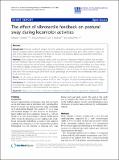| dc.contributor.author | Wall, Conrad | |
| dc.contributor.author | Sienko, Kathleen H. | |
| dc.contributor.author | Balkwill, M. David | |
| dc.contributor.author | Oddsson, Lars I. E. | |
| dc.date.accessioned | 2013-08-22T13:44:55Z | |
| dc.date.available | 2013-08-22T13:44:55Z | |
| dc.date.issued | 2013-08 | |
| dc.date.submitted | 2012-09 | |
| dc.identifier.issn | 1743-0003 | |
| dc.identifier.uri | http://hdl.handle.net/1721.1/79914 | |
| dc.description.abstract | Background:
Although significant progress has been achieved in developing sensory augmentation methods to improve standing balance, attempts to extend this research to locomotion have been quite limited in scope. The goal of this study was to characterize the effects of two real-time feedback displays on locomotor performance during four gait-based tasks ranging in difficulty.
Methods:
Seven subjects with vestibular deficits used a trunk-based vibrotactile feedback system that provided real-time feedback regarding their medial-lateral (M/L) trunk tilt when they exceeded a subject-specific predefined tilt threshold during slow and self-paced walking, walking along a narrow walkway, and walking on a foam surface. Two feedback display configurations were evaluated: the continuous display provided real-time continuous feedback of trunk tilt, and the gated display provided feedback for 200 ms during the period immediately following heel strike. The root-mean-square (RMS) trunk tilt and percentage of time below the tilt thresholds were calculated for all locomotor tasks.
Results:
Use of continuous feedback resulted in significant decreases in M/L trunk tilt and increases in percentage times below the tilt thresholds during narrow and foam trials. The gated display produced generally smaller changes.
Conclusions:
This preliminary study demonstrated that use of continuous vibrotactile feedback during challenging locomotor tasks allowed subjects with vestibular deficits to significantly decrease M/L RMS trunk tilt. Analysis of the results also showed that continuous feedback was superior. | en_US |
| dc.description.sponsorship | National Institutes of Health (U.S.) (Research Grant R01 DC06201-01) | en_US |
| dc.description.sponsorship | United States. American Recovery and Reinvestment Act of 2009 | en_US |
| dc.description.sponsorship | National Science Foundation (U.S.) (CAREER program RAPD-0846471) | en_US |
| dc.publisher | BioMed Central Ltd | en_US |
| dc.relation.isversionof | http://dx.doi.org/10.1186/1743-0003-10-93 | en_US |
| dc.rights | Creative Commons Attribution | en_US |
| dc.rights.uri | http://creativecommons.org/licenses/by/2.0 | en_US |
| dc.source | BioMed Central Ltd | en_US |
| dc.title | The effect of vibrotactile feedback on postural sway during locomotor activities | en_US |
| dc.type | Article | en_US |
| dc.identifier.citation | Sienko, Kathleen H et al. “The Effect of Vibrotactile Feedback on Postural Sway During Locomotor Activities.” Journal of NeuroEngineering and Rehabilitation 10.1 (2013): 93. | en_US |
| dc.contributor.department | Massachusetts Institute of Technology. Institute for Medical Engineering & Science | en_US |
| dc.contributor.department | Harvard University--MIT Division of Health Sciences and Technology | en_US |
| dc.contributor.mitauthor | Sienko, Kathleen H. | en_US |
| dc.contributor.mitauthor | Wall, Conrad | en_US |
| dc.relation.journal | Journal of NeuroEngineering and Rehabilitation | en_US |
| dc.eprint.version | Final published version | en_US |
| dc.type.uri | http://purl.org/eprint/type/JournalArticle | en_US |
| eprint.status | http://purl.org/eprint/status/PeerReviewed | en_US |
| dc.date.updated | 2013-08-17T19:05:59Z | |
| dc.language.rfc3066 | en | |
| dc.rights.holder | Kathleen H Sienko et al.; licensee BioMed Central Ltd. | |
| dspace.orderedauthors | Sienko, Kathleen H; Balkwill, M; Oddsson, Lars I E; Wall, Conrad | en_US |
| mit.license | PUBLISHER_CC | en_US |
| mit.metadata.status | Complete | |
